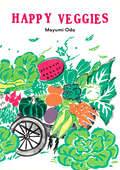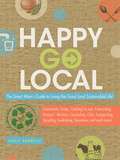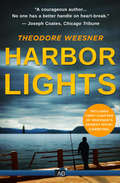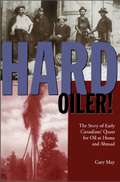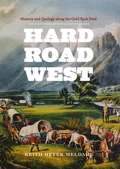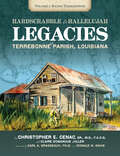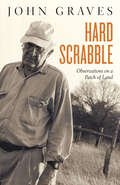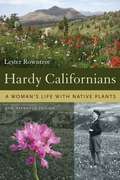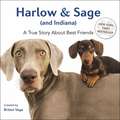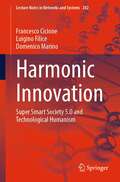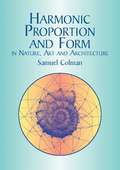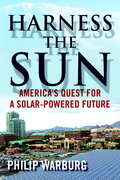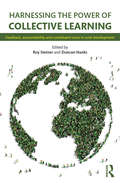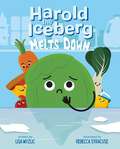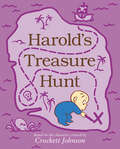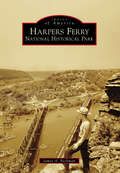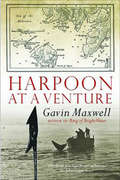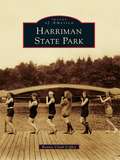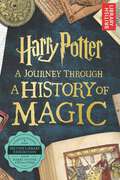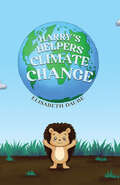- Table View
- List View
Happy Veggies
by Mayumi OdaThis book is for anyone who loves to garden and wants to invite a child to join in a delicious celebration of the fullness of life.Crisp cabbages, crunchy carrots, radiant radishes.... Vibrant illustrations of vegetables in the garden by legendary Japanese artist Mayumi Oda will inspire children to see the garden as a life-giving place where they can touch the Earth and see how Nature loves and feeds them. Starting with green and purple asparagus in the Spring, the book moves joyfully through the seasons, showing how hot and cold weather, sunshine and rain all combine to bring about a happy harvest.
Happy Winter
by Karen GundersheimerAll the happy things two young girls can do in the winter. Warm breakfast, walking in the snow, snow angels, playing games inside, making cake (with recipe), and more. All of the stories in short, easy reading rhyme. Picture descriptions have been added.
Happy-Go-Local
by Linsly DonnellyCSAs or farmers' markets?Upcycling or freecycling?Carpools or staycations?All of the above?They're all great choices - but how do you decide where your family's time and energy is best spent?In Happy-Go-Local, Linsly Donnelly shares countless ideas from her own experience in living locally to help you raise a happy and sustainable family. From community swaps to cooking co-ops, her approachable, step-by-step style will inspire you to make changes that bring your family, neighborhood, and town together - one compost pile at a time.Featuring interviews and tips from professionals in the sustainable movement, this all-in-one guide takes the guesswork out of living locally - and is one item you won't want to recycle!
Happy-Go-Local
by Linsly DonnellyCSAs or farmers' markets?Upcycling or freecycling?Carpools or staycations?All of the above?They're all great choices - but how do you decide where your family's time and energy is best spent?In Happy-Go-Local, Linsly Donnelly shares countless ideas from her own experience in living locally to help you raise a happy and sustainable family. From community swaps to cooking co-ops, her approachable, step-by-step style will inspire you to make changes that bring your family, neighborhood, and town together - one compost pile at a time.Featuring interviews and tips from professionals in the sustainable movement, this all-in-one guide takes the guesswork out of living locally - and is one item you won't want to recycle!
Happy-Go-Local: The Smart Mom's Guide to Living the Good (and sustainable) Life!
by Linsly DonnellyCSAs or farmers' markets?Upcycling or freecycling?Carpools or staycations?All of the above?They're all great choices - but how do you decide where your family's time and energy is best spent?In Happy-Go-Local, Linsly Donnelly shares countless ideas from her own experience in living locally to help you raise a happy and sustainable family. From community swaps to cooking co-ops, her approachable, step-by-step style will inspire you to make changes that bring your family, neighborhood, and town together - one compost pile at a time.Featuring interviews and tips from professionals in the sustainable movement, this all-in-one guide takes the guesswork out of living locally - and is one item you won't want to recycle!
Harbor Lights
by Theodore WeesnerA lobster fisherman in Maine attempts to reconcile his rocky past in this “unforgettable novel” by the author of The Car Thief (Kirkus Reviews). Lobster fisherman Warren Hudon has made a life of almost absolute isolation on the rough waters of southern Maine. But when he is diagnosed with rapidly developing cancer, he finds himself driven to make peace with his long-estranged wife, Beatrice, and their adult daughter, Marian. Warren’s search for reconciliation forces him to confront the failures and disappointments of his past: Beatrice’s long-standing affair with a married senator; Marian’s alliance with her mother in the acrimonious split; and the daily injustices leveled against the lobstermen of Maine. Consumed by his thoughts and growing rage, Warren, a man with nothing left to lose, must decide whether he is willing to forgive those who have wronged him, or take his revenge. “Sensitively and intelligently composed . . . the novel sings with a poetic simplicity that recalls Russell Banks or Carolyn Chute.” —Publishers Weekly “Enthusiastically recommended.” —Library Journal
Hard Oiler!: The Story of Canadians' Quest for Oil at Home and Abroad
by Gary MayA hard-luck Yankee fortune seeker. A Hamilton wagon maker hoping to sell cars to the new railways. A howling swamp so isolated and foul that pioneer farmers had steered it a wide miss. An unlikely trio indeed. And yet these three seemingly unconnected elements came together at just the right moment in time, to create one of the great but little known stories of Canada’s early years.Hard Oiler! is the story of how oil was discovered near Sarnia, Ontario, one hundred and forty years ago, and how the subsequent exploitation of that oil gave birth to what is arguably the world’s most important industry today.This great Canadian milestone can be traced back to the summer of 1858 when James Miller Williams struck oil in Lambton County, in Southwestern Ontario. Soon thereafter Williams dug the first commercial oil well in North America - if not the world - and began refining and marketing his product as machine lubricant and lighting oil. This set off a chain of events that resulted in the establishment of an industry on which our very life today is so heavily dependent.Hard Oiler! traces these events including the gold rush-like frenzy that saw the overnight rise and decline of the frontier town of Oil Springs, and the creation of the much more permanent community of Petrolia, which still flashes its Victorian charm to this day. It also recalls the exotic adventures of Lambton oil drillers as they travelled the globe opening up oil fields from Java to the Ukraine, and from America to Venezuela and the Middle East.
Hard Road West: History and Geology along the Gold Rush Trail
by Keith Heyer MeldahlIn 1848 news of the discovery of gold in California triggered an enormous wave of emigration toward the Pacific. Lured by the promise of riches, thousands of settlers left behind the forests, rain, and fertile soil of the eastern United States in favor of the rough-hewn lands of the American West.
Hard Scrabble to Hallelujah, Volume 1: Legacies of Terrebonne Parish, Louisiana (America's Third Coast Series)
by Christopher Everette Cenac Sr.Winner of a 2017 Louisiana Endowment for the Humanities Book of the Year AwardThis book represents the first time that the known history and a significant amount of new information has been compiled into a single written record about one of the most important eras in the south-central coastal bayou parish of Terrebonne. The book makes clear the unique geographical, topographical, and sociological conditions that beckoned the first settlers who developed the large estates that became sugar plantations. This first of four planned volumes chronicles details about founders and their estates along Bayou Terrebonne from its headwaters in the northern civil parish to its most southerly reaches near the Gulf of Mexico. Those and other parish plantations along important waterways contributed significantly to the dominance of King Sugar in Louisiana. The rich soils and opportunities of the area became the overriding reason many well-heeled Anglo-Americans moved there to join Francophone locals in cultivating the crop. From that nineteenth century period up to the twentieth century’s side effects of World Wars I and II, Hard Scrabble to Hallelujah, Volume I: Bayou Terrebonne describes important yet widely unrecognized geography and history. Today, cultural and physical legacies such as ex-slave-founded communities and place names endure from the time that the planter society was the driving economic force of this fascinating region.
Hard Scrabble: Observations on a Patch of Land (Observations On A Patch Of Land Ser.)
by John GravesThe two-time National Book Award finalist and author of Goodbye to a River ruminates over what an &“unmagnificent&” Texas homestead has meant to him. &“A kind of homemade book—imperfect like a handmade thing, a prize. It&’s a galloping, spontaneous book, on occasion within whooping distance of that greatest and sweetest of country books, Ivan Turgenev&’s A Sportsman&’s Notebook.&” —Edward Hoagland, The New York Times Book Review &“His subjects are trees and brush, hired help, fences, soil, armadillos and other wildlife, flood and drought, local history, sheep and goats . . . and they come to us reshaped and reenlivened by his agreeably individual (and sometimes cranky) notions.&” —The New Yorker &“If Goodbye to a River was in some sense Graves&’s Odyssey, this book is his [version of Hesiod&’s] Works and Days. It is partly a book about work, partly a book about nature, but mostly a book about belonging. In the end John Graves has learned to belong to his patch of land so thoroughly that at moments he can sense in himself a unity with medieval peasants and Sumerian farmers, working with their fields by the Tigris.&” —Larry McMurtry, The Washington Post Book World &“Hard Scrabble is hard pastoral of the kind we have learned to recognize in Wordsworth, Frost, Hemingway, and Faulkner. It celebrates life in accommodation with a piece of the &‘given&’ creation, a recalcitrant four hundred or so acres of Texas cedar brake, old field, and creek bottom, which will require of any genuine resident all the character he can muster.&” —Southwest Review
Hardy Californians: A Woman's Life with Native Plants
by Lester B. RowntreeLester G. E. Rowntree (1879-1979), free-spirited adventurer and pioneering botanist, was fifty-two when she traded a comfortable home for the life of a peripatetic traveler in the California mountains, deserts, and forests. Through hundreds of magazine and journal articles, two acclaimed books, and uncounted public lectures, Rowntree shared her vast knowledge of California native plants and at the same time argued passionately for the protection of the state's bountiful flora. A mountain mystic who worshipped on Sierra peaks, bathed in alpine streams, and lived for months on beans and bread, Rowntree has remained an inspiration in native plant horticulture and plant conservation to this day. A beloved classic first published in 1936,Hardy Californians is Rowntree's poetic sketch of California and its plant life. In charming prose, she takes us along on her annual seed-collecting journey through the state and gives a concise introduction to the complexities of California flora, climate, and geography. The book also gives information on the suitability of many native California plants for the garden. This new edition includes a comprehensive biographical essay, a chapter on Rowntree's horticultural legacy, an updated species list, and a complete bibliography of her writings.
Harlow & Sage (and Indiana)
by Brittni VegaINTRODUCING HARLOW & SAGE (AND INDIANA), "THE MOST ADORABLE BEST FRIENDS IN THE WORLD" (Buzzfeed) WHO HAVE TAKEN SOCIAL MEDIA BY STORM Once upon a time, Harlow's best friend was her older sister, Sage, a thoughtful and loving miniature Dachshund. Harlow and Sage had a shared love for many things, including Christmas presents and the legendary Meryl Streep. They played together, cuddled together, and shared their deepest secrets, until September 2013, when, sadly, it was Sage's time to retire to the doggie palace in the sky. Shortly after Sage's passing, Harlow's parents came home with Indiana, a Dachshund puppy with a killer sense of humor. It took a little getting used to, but after a few months of showing Indiana the ropes, Harlow began to recognize that a new adventure was about to unfold.Written in the wise and witty voice of Harlow the Weimaraner, and richly illustrated with more than 125 stunning images of the highly photogenic pups, Harlow and Sage (and Indiana) is a tale about the bond among three dogs, connected by deep love and unparalleled friendship. (It is also a little about Meryl.)
Harmonic Innovation: Super Smart Society 5.0 and Technological Humanism (Lecture Notes in Networks and Systems #282)
by Domenico Marino Francesco Cicione Luigino FiliceThis book is aimed at researchers, entrepreneurs, and innovation consultants of the 5.0 era. For many centuries, the dominant paradigm of innovation was based on competition and the protection of the achievements (closed innovation).In the early years of the new millennium, the advent of globalization and the network has made the model evolve towards open and collaborative approaches (open innovation).Both methods corresponded to a different view of the world and society.Today, in a historical phase in which the world needs to become more sustainable and equitable, from the heart of the Mediterranean, the cradle of classical civilization, a group of valuable academics, scholars, and entrepreneurs propose to the world a new and further evolution of the concept of innovation and expression of the era we are living in: the harmonic innovation, an attempt to combine science and wisdom, technique and spirit, scientific research and moral research, technological progress and new humanism, new economy and social impacts, power, and limit.Anybody who aims to discover a fragment of future is welcome to read this book.
Harmonic Proportion and Form in Nature, Art and Architecture (General Science)
by Samuel ColmanA treatise on the laws governing proportional form in both nature and the arts and sciences, this well-illustrated volume amply demonstrates how a design's geometrical construction can captivate both the eye and the mind. Flowers, shells, and other natural organisms appear here, along with artistic creations, in a mathematical study of the similarity of their constructive principles. These principles, in turn, are the fundamental elements by which nature creates harmony.The author, Samuel Colman (1832–1920), was a prominent member of the Hudson River School of painters ("Storm King on the Hudson," his 1866 oil on canvas, is one of his best-known works), and an embodiment through his life and work of the school's celebration of nature through art. As an activist in the politics of art, Colman helped form the Society of American Artists as well as the American Society of Painters in Water Colors, a relatively new medium at the time. He was also a teacher and associate of Louis Comfort Tiffany; in 1879, the two joined forces to establish an interior design firm that included Mark Twain among its clientele.This handsome and provocative volume is enhanced by 302 drawings by the author that complement and amplify each subject area discussed. It also includes an important Mathematical Analysis by the editor, C. Arthur Coan. As a multifaceted study, this book will find an audience among artists and philosophers, as well as scientists and mathematicians.
Harness the Sun
by Philip WarburgGoing from the inner city to the open desert, a seasoned environmental advocate looks at solar energy's remarkable ascent and its promise for America's future Solar power was once the domain of futurists and environmentally minded suburbanites. Today it is part of mainstream America. Scan the skyline of downtown neighborhoods, check out the rooftop of the nearest Walmart, and take a close look at your local sports arena. Chances are you'll find solar panels in those and many other unexpected places. In Harness the Sun, Philip Warburg takes readers on a far-flung journey that explores America's solar revolution. Beginning with his solar-powered home in New England, he introduces readers to the pioneers who are spearheading our move toward a clean energy economy. We meet the CEOs who are propelling solar power to prominence and the intrepid construction workers who scale our rooftops installing panels. We encounter the engineers who are building giant utility-scale projects in prime solar states like Nevada, Arizona, and California, and the biologists who make sure wildlife is protected at those sites. Warburg shows how solar energy has won surprising support across the political spectrum. Prominent conservatives embrace solar power as an emblem of market freedom, while environmental advocates see it as a way to reduce America's greenhouse gas emissions. At the same time, economic-justice activists celebrate solar's potential to lift up low-income communities, and Native American leaders welcome the income and jobs that the industry will bring to their communities. Yet solar energy has its downsides and detractors too. Conservationists worry about the impact of large solar farms on protected animal species, and some local citizens groups resent the encroachment of solar projects on farmland and open spaces. Warburg gives voice to those at the epicenter of these conflicts and points the way to constructive solutions. Harness the Sun offers a grounded, persuasive vision of America's energy future. It is a future fueled by clean, renewable sources of power, with solar at center stage.
Harnessing Foreign Investment to Promote Environmental Protection
by Jorge E. Viñuales Pierre-Marie DupuyHarnessing Foreign Investment to Promote Environmental Protection investigates the main challenges facing the implementation of environmental protection and the synergies between foreign investment and environmental protection. Adopting legal, economic and political perspectives, the contributing authors analyse the various incentives which encourage foreign investment into pro-environment projects (such as funds, project-finance, market mechanisms, payments-for-ecosystem services and insurance) and the safeguards against its potentially harmful effects (investment regulation, CSR and accountability mechanisms, contracts and codes of conduct).
Harnessing the Power of Collective Learning: Feedback, accountability and constituent voice in rural development
by Roy Steiner Duncan HanksWhat were new ideas 30 years ago, such as the concepts of participatory development and systems thinking, are now accepted norms in international development circles. The majority of professionals engaged in rural development accept the proposition that the people who participate in development should play an active role in defining, implementing, and evaluating projects intended to improve their productivity and lives. However this goal remains unrealized in many development programs. Harnessing the Power of Collective Learning considers the challenges and potential of enabling collective learning in rural development initiatives. The book presents 11 case studies of organizations trying to develop and implement collective learning systems as an integral component of sustainable development practice. Through systematic reflection on action and experience, key lessons and themes emerge regarding the nature of voice, participation, feedback loops, accountability and transparency, that will be useful for many others in the development community. This book is a useful resource for academics, practitioners and policy makers in the areas of international development, sustainable development, organizational development, philanthropy, learning communities, monitoring and evaluation and rural development.
Harold the Iceberg Melts Down (Harold the Iceberg #1)
by Lisa WyzlicAccompanied by Rebecca Syracuse’s bold, whimsical artwork, Lisa Wyzlic’s debut picture book Harold the Iceberg Melts Down is all about the importance of friendship and self-care, perfect for any young reader worried about their planet’s future.Harold is an iceberg... lettuce. (But he doesn't realize the "lettuce" part because part of his sticker has ripped off.) So one day when he sees a documentary about how the icebergs are melting, Harold starts to worry, thinking that he's melting too.As his anxiety grows and grows, and he tries to find a way to stop melting, his fellow food friends try to help him cool down in a different way.
Harold's Treasure Hunt
by Crockett JohnsonPick up the latest tale in the classic Harold and the Purple Crayon series and follow Harold as he hunts for treasure! This new story based on Crockett Johnson’s beloved character encourages readers to pick up their crayons and use their imagination to go wherever they’d like.A moonlit walk on the beach makes Harold yearn for adventure on the high seas! With his trusty purple crayon in hand, the curious Harold finds a ship and sails off to meet a pirate captain, a mermaid, and sea creatures (some friendly and some frightening), in hopes of finding treasure!Ever since the publication of Harold and the Purple Crayon in 1955, Crockett Johnson’s crayon-wielding hero has had a devoted following. This exciting new story featuring the classic character, with its clever and inventive twists, will delight fans old and new.
Harpers Ferry National Historical Park (Images of America)
by James A. BeckmanHarpers Ferry National Historical Park is a jewel of America's National Park Service. Established by legislation and signed into law by President Roosevelt in 1944, today the park encompasses thousands of acres spanning three states as well as the confluence of the Shenandoah and Potomac Rivers. While the town was ravaged by repeated floods and war, it rose like a phoenix from the ashes. As a Civil War soldier presciently wrote, "In future years travelers and tourists will eagerly resort [here] . . . and history will point out [this] spot where many acts of the great tragedy, not yet closed, took place." This book chronicles the creation and development of the national park in Harpers Ferry, a park that now affords hundreds of thousands of visitors each year the opportunity to marvel at the same scenery Thomas Jefferson said was worth a voyage across the Atlantic to see and to be able to walk the old streets where so many major acts of American history took place.
Harpoon at a Venture
by Gavin MaxwellIn this memoir, the Scottish naturalist and author of Ring of Bright Water recounts his post-World War II life as a shark fisherman in the Hebrides. A shark fishery based on the tiny Hebridean island of Soay was the beginning of Gavin Maxwell&’s enduring love affair with the west coast of Scotland. This, his first book, tells the whole story—the challenge and drama of the shark hunt, the development of catching techniques and equipment, the men who worked with him, and some of the frustrations of starting a new enterprise in post-war Scotland. Every chapter is packed with action and anecdote. In each there are also beautifully observed descriptions of sky, sea and the individual islands of the Hebrides as well as their wildlife—from gannets, puffins, Manx shearwaters, and fulmars to seals, dolphins, and whales.
Harriman State Park
by Ronnie Clark CoffeyOnce home to Native Americans and mountain settlers, Harriman State Park is today a 73-square-mile wilderness and recreation area lying 30 miles north of New York City. Offering over 200 miles of hiking trails, swimming, boating, fishing, and camping, it has been an oasis for city dwellers for 100 years. During the 1800s, the land was home to hardworking farmers, miners, and woodcutters. As the new century dawned, it evolved into a park of stunning beauty. Part of the Palisades Interstate Park System, it is the second-largest state park in New York.
Harry Potter - A Journey Through A History of Magic
by British British LibraryHarry Potter: A History of Magic is the official companion eBook to the special exhibition Harry Potter: A History of Magic that ran at the British Library in 2017 and New-York Historical Society in 2018. Explore the extraordinary subjects of the Hogwarts curriculum - Potions & Alchemy, Divination, Care of Magical Creatures, and more - and examine incredible historical artifacts, items from J.K. Rowling's personal archive, and stunning original artwork from Harry Potter series artists Mary GrandPré, Jim Kay, and Brian Selznick. This complete catalogue of the over 150 artifacts on display gives readers an up-close look at magical treasures from all over the world, and their inspiration on J.K. Rowling's magical inventions. Readers will be able to pore over ancient spell books, explore amazing illuminated scrolls that reveal the secret of the Elixir of Life, and through its unique design and functionality examine vials of dragon's blood, mandrake roots, painted centaurs and a genuine witch's broomstick. This special publication is an essential volume for all Harry Potter fans, history buffs, bibliophiles, and is a fascinating exploration of the history of the magic at the heart of the Harry Potter stories.
Harry's Helpers-Climate Change
by Elisabeth DaubeClimate Change made kid-friendly! Learn about causes and impacts of Climate Change! Discover nature and Earth’s diverse inhabitants! Learn how you can help save the Earth and become a Harry’s Helper! Engage in fun activities and experiments!

